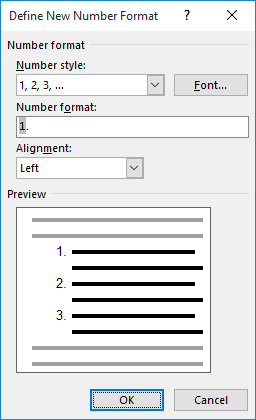Please Note: This article is written for users of the following Microsoft Word versions: 2007, 2010, 2013, 2016, 2019, and 2021. If you are using an earlier version (Word 2003 or earlier), this tip may not work for you. For a version of this tip written specifically for earlier versions of Word, click here: Changing the Types of Numbers in a Numbered List.
Written by Allen Wyatt (last updated December 1, 2023)
This tip applies to Word 2007, 2010, 2013, 2016, 2019, and 2021
When you are working with numbered lists, Word uses Arabic numerals, by default, to number the items. This number is followed by a period. You can change the numbering scheme Word uses to number your lists. Any of the following numbering types can be selected:
| Type | Selection | |
|---|---|---|
| Arabic | 1, 2, 3, 4 | |
| Uppercase Roman | I, II, III, IV | |
| Lowercase Roman | i, ii, iii, iv | |
| Uppercase Alphabetic | A, B, C, D | |
| Lowercase Alphabetic | a, b, c, d | |
| Ordinals | 1st, 2nd, 3rd, 4th | |
| Word Numbers | One, Two, Three, Four | |
| Word Ordinals | First, Second, Third, Fourth | |
| Leading Zeroes | 01, 02, 03, 04 |
You can also change the character that follows the numbered list number. To change the numbering type and the character following the number, follow these steps:

Figure 1. The Define New Number Format dialog box.
WordTips is your source for cost-effective Microsoft Word training. (Microsoft Word is the most popular word processing software in the world.) This tip (8256) applies to Microsoft Word 2007, 2010, 2013, 2016, 2019, and 2021. You can find a version of this tip for the older menu interface of Word here: Changing the Types of Numbers in a Numbered List.

The First and Last Word on Word! Bestselling For Dummies author Dan Gookin puts his usual fun and friendly candor back to work to show you how to navigate Word 2019. Spend more time working and less time trying to figure it all out! Check out Word 2019 For Dummies today!
Have you ever been frustrated by the automatic numbering feature in Word? You are not alone. Fortunately, there are a few ...
Discover MoreWant to use Word's numbering capabilities to help you number a series of questions? Here's how to accomplish the task as ...
Discover MoreWord provides tools that allow you to add numbered lists to your documents. Sometimes the quirks built into these tools ...
Discover MoreFREE SERVICE: Get tips like this every week in WordTips, a free productivity newsletter. Enter your address and click "Subscribe."
There are currently no comments for this tip. (Be the first to leave your comment—just use the simple form above!)
Got a version of Word that uses the ribbon interface (Word 2007 or later)? This site is for you! If you use an earlier version of Word, visit our WordTips site focusing on the menu interface.
Visit the WordTips channel on YouTube
FREE SERVICE: Get tips like this every week in WordTips, a free productivity newsletter. Enter your address and click "Subscribe."
Copyright © 2025 Sharon Parq Associates, Inc.
Comments